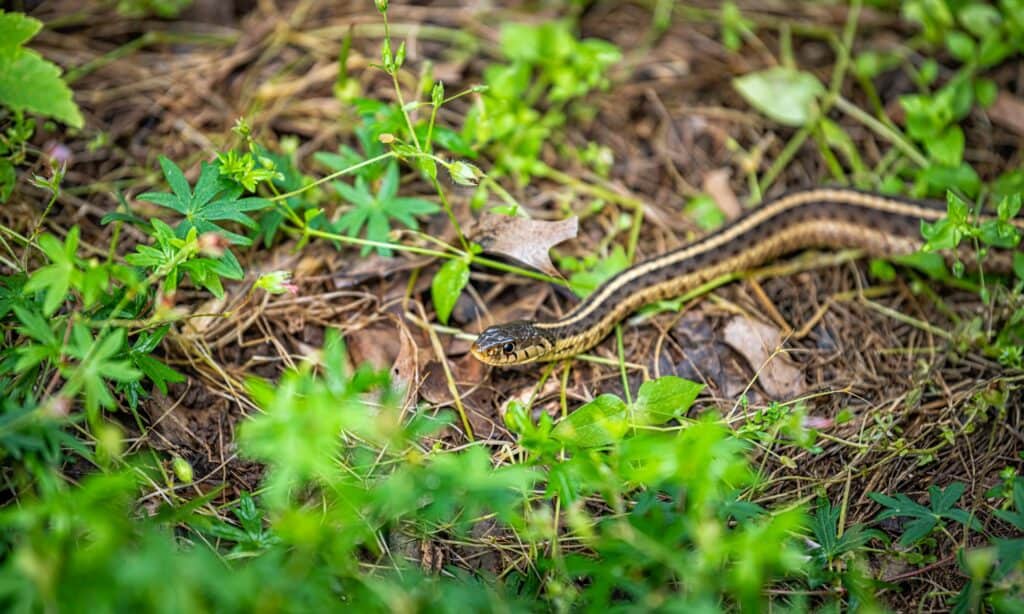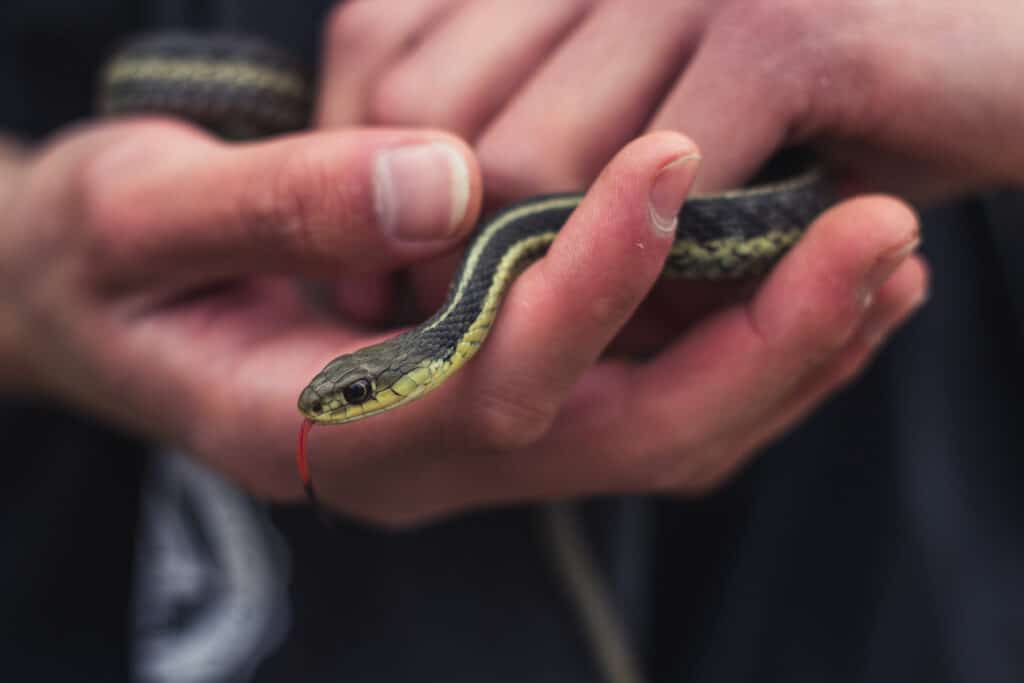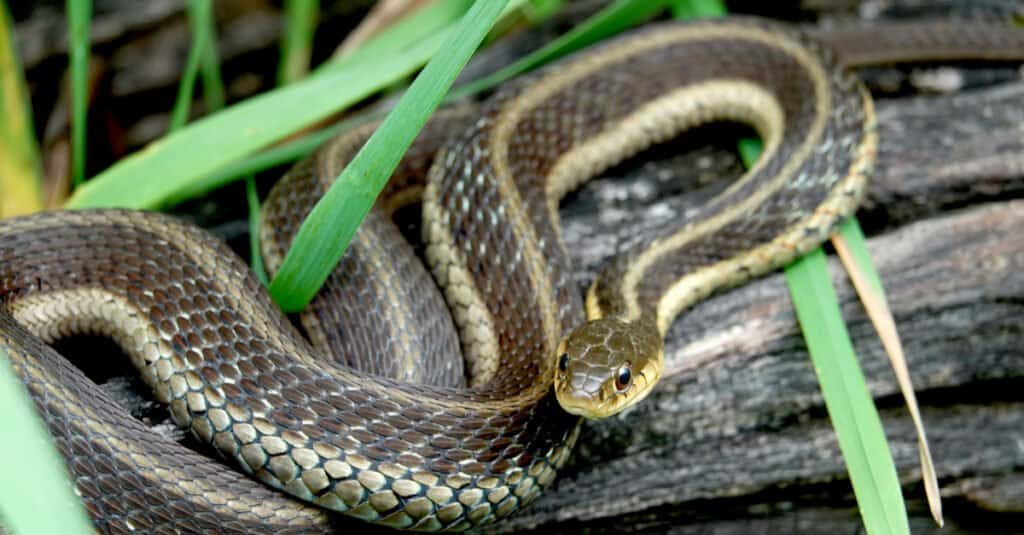Out of the 20 snake species in West Virginia, only 5 of them are poisonous (venomous). Garter snakes are usually counted among the nonvenomous variety in this state and others. This is due to the fact that, although they actually do have venom, it’s only harmful to their prey and humans are rarely at any risk. There are plenty of garter snakes in West Virginia, in fact, the eastern garter snake is the Official State Snake of West Virginia! Read on to find out all about garter snakes in West Virginia, including which species are present, where to find them and more!
The Common Garden Companion

The Eastern garter snake and Eastern ribbon snake are the two species of garter snakes found in West Virginia.
©iStock.com/krblokhin
The fear of snakes in West Virginia is mostly unfounded. According to the West Virginia Division of Natural Resources, from 1969 to 1992 only four people in the Mountain State have been killed by venomous bites in the wild. They say that bee stings, cows and horses caused 15 times as many fatalities as snakes in the state during that period.
While many snakes inspire fear despite the facts, garters have long held the reputation of being a friendly garden snake. They can often be found slithering around the yard, or garden, within brush piles or anywhere there is cover nearby. “Friendly” might not be quite accurate, as these snakes are shy like most and would rather keep to themselves. However, there is nothing to fear when you spot one. Although they’ll react and likely attempt to bite if handled inappropriately or disturbed, their venom isn’t harmful to humans. If you give them the respect and space they deserve, like most snakes, they’ll leave you alone.
Garter Snake Scientific Classification
A North American native, the garter snake gets its name from the similarity in appearance to old-fashioned sock garters. The garter snake is part of the Natricinnae subfamily, and all garters fall within one genus, Thamnophis. This genus includes roughly 35 garter snake species and the name is derived from words meaning “bush or shrub” and “snake.”
Garter Snakes in West Virginia
While garter snakes are likely to be active in the hot and humid summers in West Virginia, they go into a period of dormancy called brumation in the coldest part of winter. You can find garters in forested areas, open fields, grasslands, wetland borders and marshes. While you’re most likely to find them in your backyard in the spring and summertime, they often show up in basements in autumn and winter when the weather turns and food becomes more scarce. Garter snakes usually brumate in crevices under rocks, in trees, or the banks of streams. As they seek out their site to bed down while the weather’s cold, they’ll sometimes find their way into buildings and it can be hard for them to find their way back out.
What to do if You Find a Garter Snake

If you do need to relocate a garter snake, take care in transporting them safely.
©Jeff Saelee/Shutterstock.com
Garter snakes eat rodents and other common pests, so it’s unlikely that you’ll need to deter them. However, they can be discouraged from hanging around if necessary, by limiting cover, like brush or wood piles, and keeping grass well mowed. Also, making sure that buildings are rodent-proof will prevent them from coming indoors for a meal. Since garters and other snakes can fit through the small spaces of door and window crevices, you can ensure that those are fit properly and use a galvanized screen over potential points of entry if you don’t want to share your space.
While you may want to let the garter snakes in your home environment just do their thing, if you do find yourself needing to relocate them or handle them in any way there are a few things to keep in mind. First of all, remember that a bite from them is no big deal. The natural self-preservation reaction of a snake to being picked up is to bite. When handling a garter, support the snake with both hands for several minutes, then release the head and fully support the body with both hands. Use a hand-over-hand motion to maintain support if the snake tries to move. You want to give the snake a sense of security and let it know that you aren’t going to harm or drop it. Once it is calmly held you can transport it out of your home to a new location.
Which Garter Snake Species Live in West Virginia?
Garter snakes are abundant in West Virginia. The two species that reside there are a subspecies of the ribbon snake called the Eastern ribbon snake, and a subspecies of the common garter snake known as the Eastern garter snake. Let’s discuss the differences between these species.
Eastern Ribbon snake (Thamnophis s. sauritus):

The Eastern ribbon snake is a slender garter that prefers wetland environments.
©Steve Bower/Shutterstock.com
The Eastern ribbon snake typically inhabits the wetlands of West Virginia, especially the very swampy or marshy areas where they can feed on the aquatic animals there. This is a slender snake that grows to be up to 3 feet in length and has a long tail that makes up roughly one-third of its body length. This species typically displays 3 yellow stripes down the back, one down its center and one on each side on the 3rd and 4th rows of scales. These stripes occur over a body that is most often a rich brown in color. Eastern ribbon snakes give birth to live young like all garters, usually 10-12 per year that are 6-9 inches long at birth.
Eastern Garter Snake (Thamnophis s. sirtalis):

The Eastern garter snake is the state snake of West Virginia!
©Erik Agar/Shutterstock.com
Common in West Virginia, the Eastern garter snake can vary widely in color. They are most often green, brown or grayish with a distinct yellow or whitish stripe down the back and stripes on the 2nd and 3rd scale rows that are sometimes indistinct. This species may grow to be slightly longer than the ribbonsnake, reaching 4 feet in body length at times. While ribbonsnakes are often found in wetland areas, eastern garters may more often be found in meadows, marshes, hillsides and around lots or buildings within human populated areas. Eastern garter snakes give birth to up to 80 young per year, which are about 3 inches in length at birth.
The photo featured at the top of this post is © iStock.com/mynewturtle
Discover the "Monster" Snake 5X Bigger than an Anaconda
Every day A-Z Animals sends out some of the most incredible facts in the world from our free newsletter. Want to discover the 10 most beautiful snakes in the world, a "snake island" where you're never more than 3 feet from danger, or a "monster" snake 5X larger than an anaconda? Then sign up right now and you'll start receiving our daily newsletter absolutely free.
Thank you for reading! Have some feedback for us? Contact the AZ Animals editorial team.







